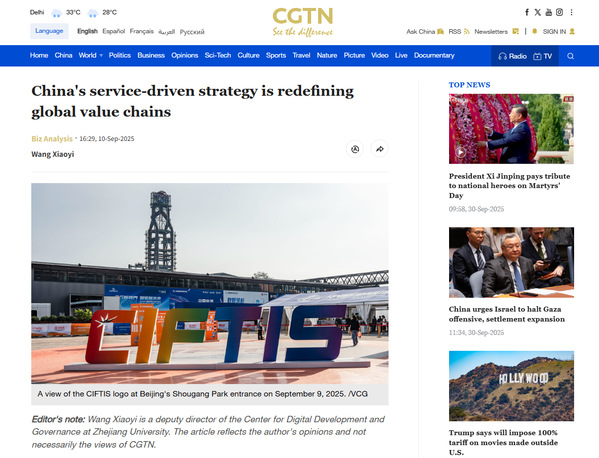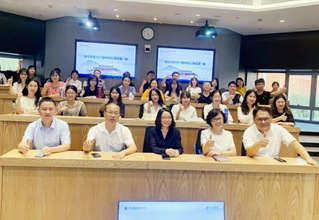
图片来源:中国国际电视台官网截图
在全球价值链加速重构的今天,服务与数字正成为推动经济转型的关键力量。中国作为全球第二大经济体,正以高水平开放与数字创新为双引擎,逐步从“世界工厂”迈向“全球服务提供者”。
浙江大学管理学院市场营销学系教授王小毅近日在中国国际电视台(CGTN)发表文章,深入分析了在全球经济格局深刻变革的背景下,中国如何通过数字驱动和服务创新重塑在全球价值链中的角色与地位。这篇文章不仅回应了当前全球经贸格局的深刻变化,也为理解中国服务贸易的未来方向提供了重要视角。

王小毅,浙江大学管理学院市场营销学系教授、浙江数字化发展与治理研究中心副主任
本期【媒体聚焦】,且看王小毅教授如何深入剖析中国在全球价值链中的角色转变与路径探索。
全球价值链重构中的中国服务新叙事
文/王小毅
作为长期研究全球价值链(GVC)的学者,我观察到一个重要的趋势,地缘政治冲突、数字化浪潮、供应链韧性需求以及可持续发展目标,正合力推动全球价值链从制造业主导转向服务导向和知识密集型模式。而在这个转型中,中国作为全球第二大经济体和服务贸易大国,通过“高水平开放”和“数字创新”双轮驱动,与国际伙伴共同实现从价值链的边缘角色向核心力量的跃升。中国的“再全球化”努力,不仅能缓解当前碎片化风险,还能为全球经济注入更包容的活力。中国取得这些成绩的背后,主要得益于市场驱动的创新、企业的活力、庞大的消费市场以及与全球伙伴的协作,这些因素合力提升了其在知识密集型服务领域的竞争力。
01全球价值链正在经历重构
过去几十年,“超级全球化”一度让全球价值链向集中规模化发展。但近年来,新冠疫情等突发事件暴露了传统供应链逻辑的脆弱性,而同时产生的地缘政治博弈则进一步加剧了价值链的区域化和碎片化。根据麦肯锡等报告,2025年约70-80%的企业将优先考虑将自身的供应链从集中转向多元化。在我看来,这并非简单的退缩,而是全球转向更可持续模式的机遇——包括中国在内的国家,正通过服务贸易构建合作桥梁,促进全球化从单极竞争向多样化协作转型。
不同于某些排他性的“去风险”策略,国际合作倡议如“一带一路”正成为连接跨区域资源的桥梁。2025年前4个月,中国服务出口达1.13万亿元,同比增长14.6%,知识密集型服务出口达5902.4亿元,这凸显新兴经济体在全球服务贸易中的上升势头。例如,中欧班列的数字化升级,通过中国铁路与德国DB Schenker等伙伴的合作,运用5G和AI优化跨境物流,覆盖40多个国家,显著提升效率并降低成本约20%。这样的实践证明,服务业能有效化解贸易壁垒,推动全球资源共享。中国在这一领域的成功,源于其通过市场开放吸引外资和技术转移,实现从被动参与到主动贡献的转变,与全球伙伴共同构建互惠网络。
02全球服务业:从“嵌入”到“塑造”价值链
全球服务业正从单纯规模扩张转向质量提升,在许多国家占GDP比重超过50%,数字经济渗透率约45%,从而从价值链下游支持角色转向上游主导。在这个过程中,中国作为重要参与者,正与国际伙伴共同发力。这种转变打破了传统“微笑曲线”中发展中国家被锁定在低端的宿命,通过知识密集型创新延长价值链,实现更均衡的全球分工。
例如,在汽车领域,华为和腾讯的车联网解决方案在中国电动汽车市场占有显著份额,并逐步影响全球发展;在航空制造中,西安地区通过飞机维修和设计外包嵌入波音、空客供应链,出口增长约20%;在数字服务上,阿里云2025年上半年向东南亚和中东输出服务,营收增长26%,助力当地数字化。笔者相信,这将重塑全球经济格局,让更多国家受益于技术溢出。中国通过市场导向的嵌入模式,不仅提升了自身产业升级,还为全球价值链贡献了高效的知识密集型服务解决方案。
03双引擎发力:开放与创新的全球协同效应
“高水平开放”和“数字创新”是中国的全球服务业融入价值链的核心动力。在开放方面,国际贸易协定如RCEP深化区域合作,中国通过市场准入扩大吸引外资,2023年扩展服务贸易创新试点至6个城市,2022年服务业外资占比超70%。抖音和阿里的跨境电商服务,2025年上半年显著带动“一带一路”沿线农产品出口欧洲,关联出口达数百亿元。这体现了新兴市场与发达经济体的互补性,而且这种开放能减少地缘摩擦,促进共赢。
在创新方面,全球数字经济迅猛扩张,中国数字经济占GDP超10%,生成式AI专利领先全球。华为5G覆盖多国,2025年向非洲和拉美出口大量基站;宁德时代1000公里续航电池技术,推动电动汽车价值链升级。这些创新彰显数字技术对服务竞争力的赋能。创新不应局限于一国,而应通过全球协作,避免技术壁垒加剧不平等。中国在这一领域的成就,得益于企业的研发投入和国际人才流动,这些因素支撑其从价值链下游向上游攀升,并贡献可持续创新模式。
04全球服务的价值:集聚资源与溢出创新
新兴市场如中国的庞大规模,使其成为全球服务资源的“引力场”。2023年,中国PCT专利申请量超过美国,2023-2025年服务业吸引外资超3000亿美元。同时,创新通过价值链向外溢出:秘鲁Chancay港采用上海智能物流系统,效率提升约20%;比亚迪在欧洲部署充电网络,服务出口显著增长,成为“绿色全球化”标杆。这些溢出效应为发展中国家提供避开“中等收入陷阱”的路径,推动全球从零和博弈转向共享繁荣。中国的对外基础设施投资和绿色技术输出,不仅提升了本地效率,还为全球贡献了低碳服务模式。
05挑战与展望
展望2030年,服务业将主导全球价值链,通过“再全球化”理念,形成开放协同的新体系。只有加强国际对话,才能化解挑战,实现可持续增长。在此背景下,全球都开始重视“服务全球嵌入和价值贡献的中国模式”:这一模式以市场驱动、创新活力和国际合作为核心,通过多边平台如“一带一路”和RCEP嵌入全球价值链,同时输出知识密集型服务和技术溢出,实现从“世界工厂”向“全球服务提供者”的转型。这种模式强调互惠共赢、可持续发展和企业家精神,不仅提升中国自身竞争力,还为新兴经济体提供可复制路径,推动全球价值链向更绿色、包容的方向演进,与市场经济原则相契合,促进全球经济治理的公平与效率。
从“嵌入者”到“塑造者”,中国正在全球服务价值链中书写新的叙事。通过数字技术的深度融合与高水平的对外开放,中国不仅提升了自身在全球分工中的位置,也为新兴经济体提供了可借鉴的发展路径。未来,随着服务业在全球价值链中主导地位的进一步确立,中国以市场驱动、创新协同为核心的“服务出海”模式,有望推动全球走向更加绿色、包容、互惠的经济新秩序。
刊发英文报道
The global value chain (GVC) is undergoing a profound transformation, driven by geopolitical tensions, the digital revolution, the need for supply chain resilience, and sustainability imperatives. As a scholar of international economics and GVCs, I observe that these forces are shifting the focus from manufacturing dominance to service-oriented, knowledge-intensive models. In this shift, China – the world's second-largest economy and a major player in service trade – has leveraged open markets and digital innovation to evolve from a peripheral participant to a central force in GVCs. This re-globalization approach not only mitigates fragmentation risks but also injects inclusive vitality into the global economy. China's progress in these areas draws from market-driven innovation, dynamic enterprises, a vast consumer base, and robust global partnerships, which together enhance its competitiveness in knowledge-intensive services; though challenges like domestic economic slowdowns and inequality remain hurdles to sustained growth.
A global value chain in flux
For decades, hyper-globalization fueled highly fragmented production networks within GVCs. Yet, recent disruptions – from the fragility exposed by the COVID-19 pandemic to geopolitical rivalries spurring de-risking strategies – have pushed value chains toward regionalization and fragmentation. Reports from McKinsey and others suggest that by 2025, roughly 70-80 percent of companies will prioritize supply chain diversification. This isn't mere retrenchment but an opportunity for a more sustainable global framework. Countries, including China, are using service trade to bridge divides, steering globalization toward cooperative and diverse models.
Unlike exclusionary de-risking approaches, initiatives like the Belt and Road connect resources across regions. In the first four months of 2025, China's service exports reached $160 billion, up 14.6 percent, with knowledge-intensive services accounting for $83 billion. A prime example is the digital upgrade of the China-Europe Railway Express: through partnerships with firms like Germany's DB Schenker, 5G and AI have optimized cross-border logistics, spanning over 40 countries, boosting efficiency and cutting costs by about 20 percent. Such efforts show how services can dismantle trade barriers and foster global resource sharing. China's achievements here reflect its ability to attract foreign investment and technology through market openness, transitioning from a passive player to an active contributor in global networks.
Services: From embedding to shaping global value chains
The global service sector is moving beyond scale to prioritize quality, contributing over 50 percent to GDP in many nations, with digital economy penetration at around 45 percent. This shift elevates services from supporting roles to leading positions in GVCs. China, a key player, collaborates with international partners to drive this change, breaking the traditional smile curve that traps developing nations in low-value roles and fostering a more balanced global division of labor through knowledge-intensive innovation.
Consider the automotive sector, where Huawei and Tencent's connected-car solutions dominate China's electric vehicle market and influence global trends. In aviation, regions like Xi'an integrate into Boeing and Airbus supply chains through maintenance and design outsourcing, with exports growing by about 20 percent. In digital services, Alibaba Cloud's first-half 2025 revenues in Southeast Asia and the Middle East rose 26 percent, aiding local digital transformation. These examples underscore the services' shift from adaptation to creation. I believe this restructuring will redistribute economic benefits, with China's market-driven integration enhancing its own industries while offering efficient, knowledge-intensive solutions to the GVC – provided it addresses internal issues like regulatory hurdles.
Dual engines: Openness and innovation in global synergy
Open markets and digital innovation are the twin pillars of China's integration into global value chains, amplified by international collaboration. On openness, frameworks like the Regional Comprehensive Economic Partnership (RCEP) deepen regional ties. China has expanded market access, extending service trade pilot programs to six cities in 2023, with services attracting over 70 percent of foreign direct investment in 2022. Platforms like TikTok and Alibaba have driven significant agricultural exports from Belt and Road countries to Europe in early 2025, generating billions of US dollars in related trade. This synergy between emerging and developed economies reduces geopolitical frictions and fosters mutual gains, with China's progress tied to market-driven regional integration and cooperative frameworks.
On innovation, China's digital economy exceeds 10 percent of GDP, and it leads in generative AI patents globally. Huawei's 5G networks span multiple countries, with substantial base station exports to Africa and Latin America in 2025. CATL's 1,000-kilometer-range battery technology is advancing the global electric vehicle value chain. These innovations highlight digital technology's role in enhancing service competitiveness. I argue that innovation must be collaborative to prevent technological barriers from deepening inequality. China's advancements, fueled by enterprise R&D and global talent flows, support its climb to higher-value roles and contribute sustainable models to the world.
The global impact of services: Resource aggregation and innovation spillovers
The scale of emerging markets like China makes them magnets for global service resources. In 2023, China surpassed the US in PCT patent applications, and from 2023 to 2025, its service sector attracted over $300 billion in foreign investment. Innovations are spilling over: Peru's Chancay Port, using Shanghai's smart logistics systems, has seen efficiency gains of about 20 percent; BYD's charging networks in Europe have spurred significant service export growth, setting a green globalization standard. These spillovers offer developing nations pathways to bypass the middle-income trap, shifting global dynamics from zero-sum to shared prosperity. China's infrastructure investments and green technology exports enhance local efficiency while contributing to low-carbon service models globally.
Challenges and the road ahead
Geopolitical barriers and technological bottlenecks persist as challenges for global services. China is addressing these with approximately $800 billion in special bonds in 2025 to support innovation, including in services. By 2030, services are poised to dominate GVCs, with re-globalization fostering open and collaborative systems. Stronger international dialogue is essential to overcome obstacles and achieve sustainable growth.
In this context, I propose the China model of global service integration and value creation: a framework rooted in market-driven innovation, entrepreneurial dynamism, and international cooperation. Through platforms like the Belt and Road Initiative and RCEP, China embeds itself in GVCs while exporting knowledge-intensive services and technological spillovers. This model, emphasizing mutual benefit, sustainability, and private-sector vitality, aligns with market economy principles, enhancing China's competitiveness and offering replicable strategies for emerging economies. It drives GVCs toward greener and more inclusive horizons, promoting fairness and efficiency in global economic governance – though its full potential depends on navigating domestic pressures like economic inequality.
In this pivotal era of GVC restructuring, services are redefining globalization's narrative, moving from passive integration to active leadership. Through efficient, green and inclusive solutions, international collaboration will power value chain evolution, forging a more equitable global economic order.
信息来源:中国国际电视台
封面图片:©千库网





